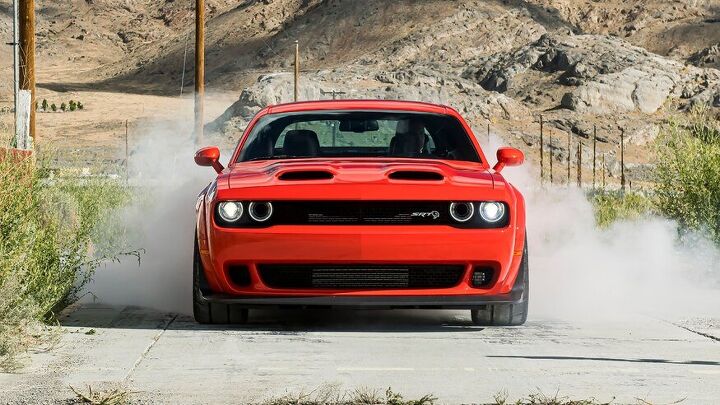Dodge Challenger Finally Takes Sales Crown

For the first time since American muscle returned to the assembly line in earnest, Dodge’s Challenger has managed to outsell both the Ford Mustang and Chevrolet Camaro inside the United States. Though Mopar fans might point out that Dodge would win every year if we bothered to include Charger sales in the headcount or were more precise when making determinations about what constitutes a muscle vs pony car.
Regardless of semantics, the Big Three have their performance icons and the Challenger has taken the two-door sales crown for the first time in modern history. Sadly, it was less about Dodge making inroads with new customers than it was about the other brands flubbing things. Performance vehicles aimed at the middle class are presently experiencing a rough patch, with the Challenger having lost the least amount of ground in the last decade.
Dodge’s crosstown rivals have been slipping the last few years — with Ford and Chevy’s most-recent highwater marks having taken place during the Obama administration. Blue Oval managed to move 122,349 Mustang domestically in 2015, while the Camaro peaked with 91,314 deliveries in 2012. During this period, Dodge’s Challenger could reliably count on between 40,000 and 60,000 U.S. sales annually.
In 2021, Mustang volumes had fallen all the way to 52,384 and the Camaro was only able to make 21,893 deliveries. Meanwhile, Dodge managed to sell 54,315 Challengers and another 78,388 examples of the Charger sedan to U.S. customers.
Speculating as to why, your author would argue that Challengers simply make more sense as a commuter vehicle and are a relative bargain compared to what’s being offered by Ford and Chevrolet. They’re exceptionally comfortable, have gigantic trunks, and maybe the only coupe left in existence where you can comfortably seat full-grown adults behind the driver. Challengers also appear custom-made for prolonged stints on the highway, whereas the Mustang and Camaro seem more at home being slung around backroads. But there are plenty of people ready to tell you that the Dodge is too damn big, too damn old, and lacks the poise of its rivals — all of which are valid criticisms.
Dodge CEO Tim Kuniskis had his own ideas about why the Challenger has been holding its ground. During a recent interview, he told Automotive News that he believed his company weathered the supply chain problems better than its chief rivals. But he also said that he doesn’t really see the model as directly comparable. While undoubtedly a distinctly American performance vehicle, he said the Challenger’s greatest strength is “not trying to follow anybody else.”
“That’s why I said we don’t wake up trying to chase Mustang and Camaro,” he explained. “Not that I don’t think they’re viable competitors. They’re phenomenal cars; they’re just different cars. They’re different than what we’re trying to do.”
Kuniskis likewise discussed how Dodge has been building a community that he feels other marques lack. However the outward messaging has been changing as the company prepares to shift toward electrified vehicles.
From AN:
The brand is expected to launch a plug-in hybrid model in 2022 and a battery-electric muscle car in 2024. It also will show an electric concept this year.
Redesigned versions of the Challenger and Charger are expected to drop internal combustion and move to Stellantis’ electrified STLA Large platform, which is capable of up to 500 miles of range.
Kuniskis said the brand’s track record should give fans reason to look forward to a future of electrified muscle.
“They acknowledge the fact that we do muscle cars different, and therefore we’ll probably do electrification different,” Kuniskis said. “And that’s why I’ve been very vocal to tell people when we do electrification, it will be different. When we launch our concept car here in the next four months or so, we’re literally going to lay out how we’re doing it differently.”
As a degenerate Mopar fan myself, I’m excited to see what Dodge has planned for the future. But I don’t know many people who are all that enthusiastic to see the Charger and Challenger dropping V8 engines. Something about the rumored turbocharged straight-six hybrid also feels sacrilegious and unsettlingly European. It might make for a stellar powertrain and even a better vehicle on the whole. But it feels at odds with Dodge’s existing branding and enthusiasts of a certain vintage are going to be turned off.
[Images: Dodge]

A staunch consumer advocate tracking industry trends and regulation. Before joining TTAC, Matt spent a decade working for marketing and research firms based in NYC. Clients included several of the world’s largest automakers, global tire brands, and aftermarket part suppliers. Dissatisfied with the corporate world and resentful of having to wear suits everyday, he pivoted to writing about cars. Since then, that man has become an ardent supporter of the right-to-repair movement, been interviewed on the auto industry by national radio broadcasts, driven more rental cars than anyone ever should, participated in amateur rallying events, and received the requisite minimum training as sanctioned by the SCCA. Handy with a wrench, Matt grew up surrounded by Detroit auto workers and managed to get a pizza delivery job before he was legally eligible. He later found himself driving box trucks through Manhattan, guaranteeing future sympathy for actual truckers. He continues to conduct research pertaining to the automotive sector as an independent contractor and has since moved back to his native Michigan, closer to where the cars are born. A contrarian, Matt claims to prefer understeer — stating that front and all-wheel drive vehicles cater best to his driving style.
More by Matt Posky
Latest Car Reviews
Read moreLatest Product Reviews
Read moreRecent Comments
- Wjtinfwb Looks in decent nick for a Junkyard car. Other than the interior being partially gutted for some trim pieces, you could probably drive it out of the junkyard. Maybe a transmission issue and the cars value precluded a $2k or more fix? J cars were pathetic when introduced in '82 and never really got any better. But GM did sort out most of the reliability issues and with a modicum of maintenance these would run a long time if you could stand the boredom. Guess this owner couldn't.
- GS340Pete I see a lot of these on the road. I can't remember the last time I saw one on my local Chevy dealership's lot. They've never in my memory had a few lined up with balloons. Short sighted to kill it off? Perhaps. But I certainly think the rows of $65k and up trucks is short sighted. That's going to bite soon. Looks like they're piling up already.And what about the Trax? Malibu or Trax? Gotta be honest, I'd pick the Trax.Although it should have 50 more HP IMHO. And why are so many preaching doom about the 'wet belt' engine?RIP, Malibu. Ride the highway in the sky with the Impala (talk about short sighted.)
- ToolGuy GM didn't care about these and you shouldn't either. 😉
- FreedMike Yet another GM Deadly Sin: trot out something in what was a very competitive and important market segment that hadn't been restyled in 11 model years, and was based on a platform that was over 20 years old, and expect people would be dumb enough to buy it over a Corolla or Civic (or a Focus, for that matter).
- TheMrFreeze Makes you wonder if he's seeing something with Stellantis he doesn't like and wanted out as a result. As somebody with three FCA vehicles in their driveway, Stellantis is sounding more and more like DaimlerChrysler 2024 🤬





































Comments
Join the conversation
I would prefer a muscle car any day to a truck with poor handling and a rough ride. A few years-ago I was helping with a move, and we used a F-150. It was one of the most uncomfortable rides I have ever experienced.
Here's a maroon Dodge Challenger in the news: https://www.reviewjournal.com/local/north-las-vegas/9-dead-in-north-las-vegas-crash-involving-speeding-2521066/